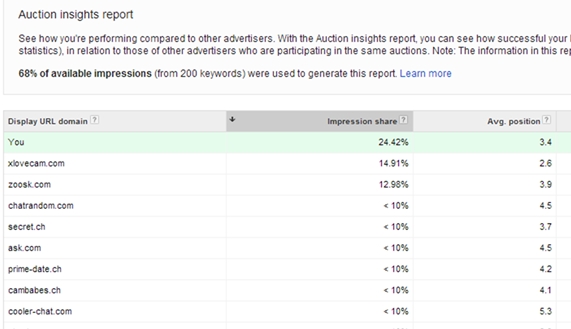
Google Adwords is not only a great advertising platform, enabling sites to be tightly targeted at very specific niches; it is also a very valuable investment in a marketing intelligence database with some excellent analytical tools which can be used both to sharpen and improve PPC (Pay Per Click) campaigns, and provide keyword research insight for SEO improvement.
In my last article on Google Adwords, I focused on how to explore keyword search terms to identify long tail keywords that could support improved PPC campaigns and SEO. In the same analytics section, there are two further options to explore, Auction Insights and Keyword Diagnosis. But before getting into those, there are some key measures that need to be included as standard in Adwords reporting.
There is a tab “Columns” which when clicked opens up a drop down set of menus; click on the “Competitive Metrics” link to reveal some important key metrics to add to the main reporting screens:

Below is an extract of these indicators for two different keywords and how to interpret them:

Search impression share is the impressions that you’ve received on the Search Network divided by the estimated number of impressions that you were eligible to receive. This metric can help you identify potential opportunities to get more impressions and clicks. It’s updated once a day.
Search Exact match impression share is the impressions that you’ve received divided by the estimated number of impressions that you were eligible to receive on the Search Network for search terms that matched your keywords exactly. This metric can identify potential opportunities to capture more exact match impressions and clicks. It’s updated once a day.
Search Lost impressions share (rank) refers to the estimated percentage of impressions on the Search Network that your ads didn’t receive due to a poor Ad Rank. A high Search Lost IS (rank) means there were many times your ad was eligible to show on the Search Network but didn’t because its Ad Rank was too low. Search Lost IS (rank) is updated once a day. If you’re seeing a high Search Lost IS (rank), then try increasing your bid or improving your Quality Score. If you’re not seeing a number at all, this could be because you ran out of budget during this date range.
Relative CTR measures how your ads perform on Display Network sites compared to other ads on the same sites. Relative CTR is your click-through rate divided by the average click- through rate of all advertisers on the websites that show your ads.
Example: A Relative CTR of 1x means that your CTR equals the average CTR of all advertisers in the same section of a website. Relative CTR can help you understand campaign and ad group performance, particularly if you have little or no conversion information.
HOT TIP: a method to identify how many impressions that keywords generate in total is to take the Search Impression share and divide it into the number of impressions that have been served on the keyword. This is important to identify and evaluate true keyword impressions as the number of impressions that are reported does not represent the total number of impressions generated for a keyword. It represents the impressions that your ad was eligible for, a key difference. This true number of impressions can be worked out using this calculation, and is a way of identifying potential high volume keywords to use in metatags and site titles.
Auction Insights is worth checking regularly and can be accessed here:

This is the report generated, which lists competitors and their relative share of impressions:

Under the Keyword Diagnosis section, each keyword generates the following overview by clicking on the “dialogue” button highlighted:

This information can be used in conjunction with Impression Share to target campaign performance improvement.
In Summary:
- Google Adwords is a great investment in both traffic generation and niche marketing intelligence;
- There are some great metrics which give a superb insight into both PPC keyword performance and potential high volume keywords for SEO;
- Auction Insights expose competitors in the niche’
- Keyword Diagnostics provides insights into visitor experience when they land on the site;
- Total keyword impressions can be calculated to identify high volume, and potentially high value keywords.
Good luck!